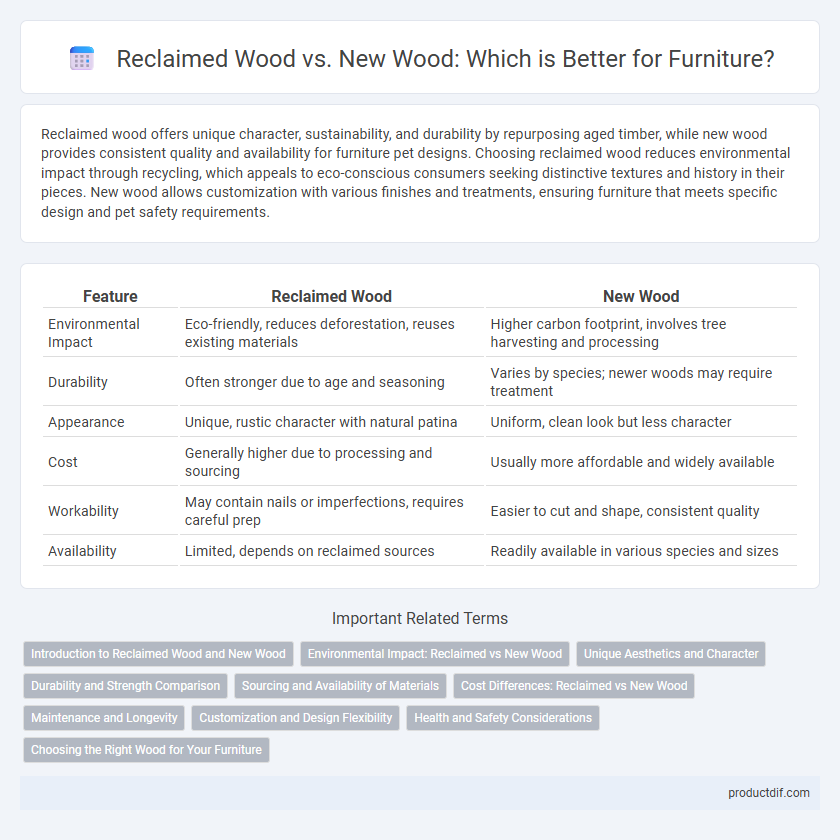Reclaimed wood offers unique character, sustainability, and durability by repurposing aged timber, while new wood provides consistent quality and availability for furniture pet designs. Choosing reclaimed wood reduces environmental impact through recycling, which appeals to eco-conscious consumers seeking distinctive textures and history in their pieces. New wood allows customization with various finishes and treatments, ensuring furniture that meets specific design and pet safety requirements.
Table of Comparison
| Feature | Reclaimed Wood | New Wood |
|---|---|---|
| Environmental Impact | Eco-friendly, reduces deforestation, reuses existing materials | Higher carbon footprint, involves tree harvesting and processing |
| Durability | Often stronger due to age and seasoning | Varies by species; newer woods may require treatment |
| Appearance | Unique, rustic character with natural patina | Uniform, clean look but less character |
| Cost | Generally higher due to processing and sourcing | Usually more affordable and widely available |
| Workability | May contain nails or imperfections, requires careful prep | Easier to cut and shape, consistent quality |
| Availability | Limited, depends on reclaimed sources | Readily available in various species and sizes |
Introduction to Reclaimed Wood and New Wood
Reclaimed wood originates from salvaged materials such as old barns, factories, and warehouses, offering unique textures, rich patinas, and eco-friendly benefits by reducing deforestation. New wood, sourced directly from freshly harvested trees, provides uniformity, consistent quality, and greater availability for customized furniture designs. Choosing between reclaimed wood and new wood depends on factors like sustainability goals, desired aesthetic, and budget constraints.
Environmental Impact: Reclaimed vs New Wood
Reclaimed wood significantly reduces environmental impact by minimizing deforestation and lowering carbon emissions associated with harvesting and processing new timber. New wood production often involves intensive resource consumption, habitat disruption, and increased waste generation. Choosing reclaimed wood promotes sustainability by repurposing existing materials and conserving natural forests.
Unique Aesthetics and Character
Reclaimed wood offers unique aesthetics and character with its weathered textures, natural imperfections, and historical patina that cannot be replicated by new wood. Each plank tells a story through visible nail holes, knots, and varied grain patterns, adding depth and authenticity to furniture pieces. In contrast, new wood provides a uniform, clean appearance but lacks the rich, distinctive charm found in reclaimed materials.
Durability and Strength Comparison
Reclaimed wood often exhibits superior durability and strength due to years of natural aging and exposure, which can increase its density and hardness, making it highly resistant to wear and damage. New wood, while more uniform and free from previous wear, may require treatments or finishes to match the robustness and longevity of reclaimed materials. The dense grain structure of reclaimed wood also enhances its structural integrity, making it ideal for furniture that demands long-term durability and strength.
Sourcing and Availability of Materials
Reclaimed wood is sourced from old buildings, barns, and industrial sites, offering unique character and sustainability benefits by reducing waste. New wood is harvested directly from forests, with availability depending on logging regulations, species demand, and seasonal cycles. Both materials vary in supply stability: reclaimed wood can be limited and inconsistent, while new wood generally provides more predictable quantities for large-scale furniture production.
Cost Differences: Reclaimed vs New Wood
Reclaimed wood typically costs more than new wood due to the labor-intensive process of sourcing, cleaning, and preparing the material for use in furniture making. New wood offers a more affordable option with consistent quality and availability, making it suitable for budget-conscious projects. The investment in reclaimed wood often results in unique, environmentally friendly pieces that can increase in value over time.
Maintenance and Longevity
Reclaimed wood furniture offers superior durability due to its seasoned nature, resisting warping and cracking better than new wood. Maintenance of reclaimed wood often requires periodic sealing and gentle cleaning to preserve its unique patina, while new wood typically demands more frequent refinishing and protection from moisture. Longevity of reclaimed wood furniture can surpass new wood by decades when properly cared for, making it a sustainable and long-lasting choice for furniture.
Customization and Design Flexibility
Reclaimed wood offers unique textures and character that enhance customization by providing one-of-a-kind patterns and natural imperfections not found in new wood. New wood allows greater design flexibility due to its uniformity and ease of manipulation, enabling precise cuts, shapes, and finishes for tailored furniture pieces. Both materials support diverse design goals, but reclaimed wood excels in rustic and vintage aesthetics while new wood suits modern, sleek designs.
Health and Safety Considerations
Reclaimed wood often contains old nails, lead paint, or mold, posing potential health risks that require thorough inspection and treatment before use in furniture. New wood is generally safer, being free from contaminants and treated with non-toxic finishes, which reduces the risk of allergens and chemical exposure. Proper sanding and sealing of either wood type are essential to minimize dust and splinters, ensuring safer indoor air quality and user protection.
Choosing the Right Wood for Your Furniture
Reclaimed wood offers unique character with its weathered texture and eco-friendly benefits, making it ideal for sustainable furniture projects. New wood provides consistent quality and easier customization, suitable for modern, precise designs and long-term durability. Carefully assessing your style preferences, environmental impact, and project requirements ensures the best choice between reclaimed wood and new wood for your furniture.
Reclaimed Wood vs New Wood Infographic

 productdif.com
productdif.com